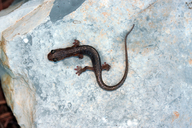|
Chiropterotriton infernalis Rovito & Parra-Olea, 2015
Sistema Purificacion Salamander; Salamandra del Sistema Purification | family: Plethodontidae subfamily: Hemidactyliinae genus: Chiropterotriton |
| Species Description: Rovito SM, Parra-Olea G 2015 Two new species of Chiropterotriton (Caudata: Plethodontidae) from northern Mexico. Zootaxa 4048: 57-74. | |
 © 2015 Sean Michael Rovito (1 of 5) |
|
|
|
Description Except for C. magnipes and C. mosaueri, C. infernalis differs from all other species of Chiropterotriton by the focal species having a large relative size of the feet to snout-vent length in males. However, C. infernalis can be differentiated from C. magnipes by less extensive foot webbing in C. infernalis. They can be further distinguished by C. infernalis having fewer premaxillary/maxillary and vomerine teeth and a darker coloration. Chiropterotriton infernalis has a relatively shorter tail than C. mosaueri, but a longer tail than C. multidentatus. Additionally, C. infernalis can be distinguished from C. arboreus, C. chiropterus, C. chondrostega, C. cracens, C. dimidiatus, C. lavae, C. miquihuanus, C. multidentatus, C. orculus, C. priscus, and C. terrestris by the focal species having more extensive foot webbing. Furthermore, C. infernalis has much smaller external nares and and more premaxillary-maxillary teeth than C. miquihuanus. More vomerine teeth in C. infernalis distinguishes it from C. lavae. A larger body size distinguished C. infernalis from C. chondrostega, C. cracens, and C. dimidiatus. Chiropterotriton infernalis has more premaxillary-maxillary teeth in males than C. chiropterus (Rovito and Parra-Olea 2015). In life, the dorsal surface from the rostrum to the insertion of the forelimbs is red to reddish-brown with dispersed clay-colored spots. The coloration can be somewhat lighter from the snout to interocular region. The dorsum can be reddish-brown with gray flecks. The dorsal side of the tail can be beige to tan with yellowish-brown spots. The dorsal parts of the limbs are a darker reddish-brown with medium-chrome orange mottling. The dorsal sides of hands and feet are reddish-brown with white flecks, while the tips of the toes are a soft pink. The ventral surface of the limbs are reddish-orange. The ventral surface of the abdomen is a medium-brown sprinkled with whitish flecks. The ventral side of the tail is brown or yellowish-brown (Rovito and Parra-Olea 2015). When preserved in alcohol the dorsum appears medium-brown with pale flecks that are plentiful upon the head. The sides of the head and from the snout to interorbital region are a light brown. The dorsal surfaces of the limbs become gray brown with a pale yellowish-mottling. The dorsal surface of the feet are gray, and the ventral side appear light grey. The ventral surface are grayish to a pale-yellow with some very pale-yellow mottling on the gular region (Rovito and Parra-Olea 2015). Quantities of vomerine and maxillary teeth can be significantly different with the largest collected specimen having 36 premaxillary and maxillary teeth (Rovito and Parra-Olea 2015). Distribution and Habitat Country distribution from AmphibiaWeb's database: Mexico
Larva Trends and Threats Due to its cave-dwelling habitats it is likely climate change will not impact this species heavily (Rovito and Parra-Olea 2015). The species is not currently protected, but occurs in an area with few settlements (Rovito and Parra-Olea 2015). Possible reasons for amphibian decline General habitat alteration and loss Comments The species epithet, “infernalis” is Latin for “infernal, hellish, or lower”, which is a reference to the subterranean cave-dwelling habitats of this species. Sistema Purificación cave system is so extensive it has not been fully explored (Rovito and Parra-Olea 2015).
References
Basanta, M.D., Rebollar, E.A., Parra-Olea, G. (2019). "Potential risk of Batrachochytrium salamandrivorans in Mexico." PloS one 14(2): e0211960. [link] Rovito, S.M., Parra-Olea, G. (2015). "Two new species of Chiropterotriton (Caudata: Plethodontidae) from northern Mexico." Zootaxa 4048(1): 57-74. [link] Yap, T., Koo, M., Ambrose, R.F., Wake, D.B., Vredenburg, V.T. (2015). "Averting a biodiversity crisis." Science 349(6247), 481-482. [link] Originally submitted by: Bryan Hicks (2022-10-06) Description by: Bryan Hicks (updated 2022-10-06)
Distribution by: Bryan Hicks (updated 2022-10-06)
Larva by: Bryan Hicks (updated 2022-10-06)
Trends and threats by: Bryan Hicks (updated 2022-10-06)
Comments by: Bryan Hicks (updated 2022-10-06)
Edited by: Ann T. Chang (2022-10-06) Species Account Citation: AmphibiaWeb 2022 Chiropterotriton infernalis: Sistema Purificacion Salamander; Salamandra del Sistema Purification <https://amphibiaweb.org/species/8400> University of California, Berkeley, CA, USA. Accessed Feb 4, 2025.
Feedback or comments about this page.
Citation: AmphibiaWeb. 2025. <https://amphibiaweb.org> University of California, Berkeley, CA, USA. Accessed 4 Feb 2025. AmphibiaWeb's policy on data use. |



 Raffaëlli Account
Raffaëlli Account Map of Life
Map of Life